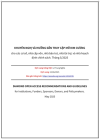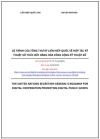Microsoft:an end to open hostilities?
Date: January 2010 (lastup-dated Mon, 04 Jan 2010)
Author: Paul Anderson,Intelligent Content
Theo:http://www.oss-watch.ac.uk/resources/microsoft.xml
Bài được đưa lênInternet ngày: 04/01/2010
Lờingười dịch: Bạn có muốn biết bản chất bên trongnhững triết lý của mô hình kinh doanh cũng như nhữngđộng thái gần đây của Microsoft đối với thế giớinguồn mở hay không, biết rằng đã có một thời, hãngnày coi phần mềm tự do nguồn mở (FOSS) như là một mảnhđất cộng sản, rồi nhạo báng như một dạng ung thư,rồi sau đó nâng cấp thành dạng 'bóng ma màu xám', rồigần đây lại tài trợ cho một số dự án của QuỹApache nguồn mở, hay thành lập Quỹ “nguồn mở” củariêng mình là Codeplex... hay không? Bạn hãy đọc bài viếtnày và sẽ rõ được nhiều điều. Hy vọng là như vậy.
6.'Lõi mở' đối nghịch với 'mép mở'
Đối với một sốngười dường như sẽ có một xung đột cố hữu ở đây:Microsoft đã phát triển các giấy phép được OSI phêchuẩn, vâng nó còn kết hợp được với mô hình IP hạnchế của hãng. Hạnh phúc để làm việc trên các phầnmềm nguồn mở và cam kết cho mã nguồn, nhưng chỉ ởnhững nơi mà những nỗ lực cổ vũ cho tính tương hợpvới các sản phẩm nguồn mở và gia tăng sự thâm nhậpthị trường nguồn mở của Microsoft
Đối với DarrenStrange, điều này một phần là một hậu quả tự nhiêncủa cách mà hãng này đang thay đổi. Ông ta viện lý rằngMicrosoft không còn coi nguồn mở (như là một 'triết lý')như một đối thủ cạnh tranh. Ông tin tưởng rằng đãtừng có một 'sự chuyển dịch to lớn' bên trong công tynày, nhưng chỉ ra rằng: 'giống như nhiều thứ này, nhữngthứ mà xảy ra bên trong nội bộ cần nhiều thời giantrước khi chúng nhận thức được hoặc cảm thấy đượctrong thị trường... cần một chút thời gian để điềuđó thấm vào được và được mê say'. Điều này mộtphần là cau hỏi của một sự chuyển dịch về nhân khẩuhọc. 'Nhiều kỹ sư mà chúng tôi thuê bây giờ... đã tớivới kinh nghiệm đáng kể về nguồn mở, nên những gìbạn đang thấy là một sự tươi mới của hãng'. Ôngcũng chỉ vào Quỹ Codeplex như một ví dụ về cam kếttiếp tục của họ đối với nguồn mở. Ông nói: 'Cơ sởchính của nền tảng [Windows] của chúng tôi là khôngnguồn mở, nó là một sản phẩm thương mại, không nguồnmở, nhưng nó rất mở và mục tiêu của chúng tôi là đểđảm bảo rằng mép lề của sản phẩm của chúng tôi làcực kỳ mở'. Đây, ông viện lý, có nghĩa là sự cungcấp các giao diện lập trình ứng dụng API giàu có và sựtruy cập được làm thành tài liệu tốt đối với hệthống này, mà nó cho phép những người khác tích hợpmột cách sâu sát. Và nó có nghĩa việc làm việc cậtlực để đảm bảo các sản phẩm nguồn mở làm việcđược tốt trên đỉnh của kho phần mềm của Windows(ông viện dẫn con số 80,000 sản phẩm như vậy).
Định nghĩa này khôngphải không là những vấn đề của hãng. Khái niệm 'méplề mở' không được công nhận một cách rộng rãi trongnền công nghiệp IT và việc sử dụng nó đã gây ra tranhcãi bên trong các tổ chức như OSI. Đối với nhiều ngườitrong nền công nghiệp này thì những khái niệm được môtả ở trên như 'mép lề mở' đơn giản là những kháiniệm chống trụ công nghệ được ghi thành tài liệu mộtcách thích đáng. Đối với Strange, dù vậy, đây là cáchđể phân biệt giữa những gì Microsoft đang làm và tiếpcận thường được sử dụng bởi các công ty nguồn mở.Ông mô tả điều này như 'nhân lõi mở', trong đó cáccông ty cung cấp một sản phẩm mà nó là mở và tự donhưng lấy tiền các dịch vụ hoặc các phiên bản doanhnghiệp được cải tiến.
Strange kết luận:'Không có gì sai trái với mô hình cốt lõi nguồn mở,chỉ là việc chúng tôi là một công ty theo mô hình méplề mở và chúng tôi nghĩ nó làm việc tốt. Vì thế tôinghĩ điều này hoàn toàn thực dụng, nó là suy nghĩ tốt'.
6.'Open core' versus 'open edge'
Forsome there seems to be an inherent conflict here: Microsoft hasdeveloped OSI-approved licences, yet it remains wedded to itsrestrictive IP model. It is happy to work on open source software andcommit code, but only whe-re that endeavour enhances interoperabilitywith open source products and increases Microsoft's penetration ofthe open source market.
ForDarren Strange, this is partly a natural consequence of the way thecompany is changing. He argues that Microsoft no longer sees opensource (as a 'philosophy') as a competitor. He believes that therehas been a 'massive shift' within the company, but points out that:'like a lot of these things, things that happen internally take along time before they are acknowledged or felt in the market ... ittakes a while for that to permeate and be absorbed'. This is partly aquestion of a demographic shift. He says: 'A lot of the engineersthat we hire now ... have come in with significant open sourceexperience, so what you are seeing is a refresh of the company'. Healso points to the new Codeplex Foundation as an example of theircontinuing commitment to open source. He says: 'The CodeplexFoundation will be an independent organisation f-rom Microsoft but wewill obviously continue to actively contribute to it. To get it offto a good start, we have put $1million up to support it and Sam Ramjihimself, who is leaving Microsoft, is passionate about serving aspresident.'
'Thereis also a key business reason for this apparent conflict, whichStrange puts into context by distinguishing between 'open core' and'open edge'. He says: 'The main basis of our [Windows] platform isnot open source, it is a commercial, non-open source product, but itis very open and our objective is to ensure that the edge of ourproduct is extremely open'. This, he argues, means the provision ofrich APIsand well-documented access to the system, which allows others tointegrate closely. And it means working hard to ensure open sourceproducts work well on top of the Windows stack (he cites figures of80,000 such products).
Thisdefinition is not without its problems. The term 'open edge' is notwidely recognised in the IT industry and its use has caused debatewithin organisations such as the OSI. For many in the industry theconcepts described above as 'open edge' are simply the conceptsunderpinning properly documented technology. For Strange, though,it's a way of distinguishing between what Microsoft is doing and theapproach often used by open source companies. He describes this as'open core', in that companies provide a product that is open andfree but c-harge for services or enhanced enterprise editions.
Strangeconcludes: 'There is nothing wrong with the open core model, it isjust that we are an open edge model company and we think it workswell. So I think it is quite pragmatic, it is well thought through.'
7.Có ý nghĩa đối với Microsoft
Chúng ta có thể kếtluận gì về Microsoft và quan điểm của hãng đối vớinguồn mở? Trong khi có những người không nghi ngờ aiđang tham gia vào tranh luận nội bộ để chuyển hãng nàytheo phương hướng của cộng đồng nguồn mở và các giátrị của nó, thì dường như rõ ràng rằng sự thay đổichỉ là việc du ngoạn ở tốc độ (và theo hướng) màcác mô hình kinh doanh chính của hãng, việc sử dụngdoanh thu từ IP và nhu cầu tăng cường kho phần mềmWindows nền tảng của hãng, là quan trọng không để đánhgiá thấp điều này, khi mà, từ một viễn cảnh kinhdoanh, dễ dàng thấy cách mà nguồn mở có thể kết thúcviệc đang làm suy giảm 'chỉ' một phân khúc thị trườngmới.
Theo cách này,GNU/Linux đặt ra một vấn đề, và Mary Jo Foley duy trìđiều đó, dù có những tín hiệu của sự thay đổi thựcsự, bên trong hãng này sẽ vẫn còn có những tranh luậnquan trọng về cách làm việc với một hệ điều hành mànó hoàn toàn cạnh tranh với Windows. Bà nói: '… vẫn cònquá ít người tại Microsoft mà không thể để những cáiđầu của họ xung quanh nguồn mở - đặc biệt sự khácbiệt giữa Linux (với nó Microsoft đang cạnh tranh) và phầncòn lại của nguồn mở (mà nhiều người tại Microsoftmuốn ôm lấy)'. Trong khi điều này trước tiên là vềviệc bảo vệ mô hình kinh doanh của Microsoft, thì một sốngười đã đi xa hơn và đã đoán rằng mục tiêu là đểloại bỏ GNU/Linux hoàn toàn khỏi sự cân bằng.
Foley tiếp tục nóirằng: 'Microsoft sẽ luôn là một nhà cung cấp phần mềmsở hữu độc quyền mà nó mò khoắng trong phần mềmnguồn mở' và vì thế không ngạc nhiên, có lẽ, rằngcác nhà hoạt động xã hội về FOSS vẫn chia tách giữalàm thế nào để đối phó với những sự cướp phá củaMicrosoft trong nguồn mở. Ric-hard Stallman cho rằng dạng hoạtđộng này là na ná giống với những gì ông gọi là'việc tắm tự do', một khái niệm ông đúc kết bằng sựtương tự với 'tắm xanh', để mô tả một tình trạng'trong đó một công ty thực hiện những đóng góp nhỏ bécho sự tự do với hy vọng về việc tránh được sự chỉtrích đối với những hành động lớn hơn nhiều màchúng là có hại'. Những người khác viện lý rằng nótất cả có thể được hiểu như một động thái theochiều hướng đúng, ngay cả nếu nó chỉ vì những lý docủa riêng Microsoft. Như Jusstin Erenkrantz nói: 'Mỗi sự camkết tích cực và xây dựng mà Microsoft có với cộng đồngnguồn mở (và ngược lại), bất kể là đóng góp tiệmcận hay nhỏ nào, cũng sẽ tiếp tục làm sứt mẻ trongnhững nhận thức cũ'.
Dù những khác biệtnày thì lời khuyên tốt nhất có lẽ là tiếp tục theodõi. Microsoft không đơn giản là một tấm đá nguyên khốikhông thay đổi được. Nhiều nhà phân tích viện lý rằngkỷ nguyên của Windows đang vẽ lên hồi kết và rằngnhững lực lượng mới trong nền công nghiệp điện toán,như mô hình điện toán đám mây dịch vụ, sự nổi lêncủa các điện thoại di động và sự thành công của môhình doanh số dựa trên quảng cáo của Google, tất cả sẽép vào một dạng suy nghĩ lại có tổ chức. Việc thamgia vào trong danh sách này sẽ phải là trong con đường màFOSS đã làm về mặt tinh thần mà nó bao vây xung quanh môhình phần mềm nguồn đóng của Microsoft.
7.Making sense of Microsoft
Whatcan we conclude about Microsoft and its attitude to open source?While there are undoubtedly people who are engaging in internaldebate to move the company in the direction of the open sourcecommunity and its values, it seems clear that the change is onlytravelling at the speed (and in the direction) that the company's keybusiness models, its use of IP revenues and need to reinforce itsbasic Windows software stack, will allow. For those to whom opensource values are inseparable f-rom its products, it is important notto underestimate this, as, f-rom a business perspective, it is easy tosee how open source could end up being reduced to 'just' a new marketsegment.
Inthis respect, GNU/Linux poses a problem, and Mary Jo Foley maintainsthat, despite signs of genuine change, within the company there arestill important debates about how to deal with an operating systemthat competes directly with Windows. She says: ' ... there are stillquite a few at Microsoft who can't get their heads around open source– especially the distinction between Linux (with which Microsoftcompetes) and the rest of open source (which many at Microsoft wantto embrace)'. While this is primarily about protecting Microsoft'sbusiness model, some have gone further and speculated that the goalis to remove GNU/Linux f-rom the equation altogether.8
Foleygoes on to say that: 'Microsoft will always be a proprietary softwarevendor that dabbles in open source software' and so it isunsurprising, perhaps, that FOSS activists remain split over how torespond to Microsoft's forays in open source. Ric-hard Stallman's takeon it is that this kind of activity is akin to what he calls'freewashing', a term he coined by analogy with 'greenwashing', todescribe a situation 'in which a company makes small contributions tofreedom in the hope of evading criticism for much larger actions thatare detrimental'. Others argue that it could all be interpreted as amove in the right direction, even if it is for Microsoft's ownreasons. As Justin Erenkrantz says: 'Every positive and constructiveengagement Microsoft has with the open source community (and viceversa), no matter how small or tangential the contribution, willcontinue to chip away at the old perceptions'.
Despitethese differences the best advice is probably to keep watching.Microsoft is not simply an unchanging monolith. Many analysts arguethat the Windows era is drawing to a close and that new forces in thecomputing industry, such as the service cloud computing model, therise of mobile phones and the success of Google's advertising-basedrevenue model, are all forcing a kind of organisational rethink.Joining this list has to be the in-road that FOSS has made on thementality that surrounds Microsoft'sclosed source software model.
8.Đọc thêm (phần này không dịch. Đây là các tàiliệu tác giả bài viết giới thiệu để đọc thêm).
8.Further reading
Links:
Free Software Foundation [http://www.fsf.org/]
Open Source Initiative [http://www.opensource.org/]
The Codeplex Foundation [http://www.codeplex.com/]
Fortune magazine interview with Steve Ballmer [http://money.cnn.com/magazines/fortune/fortune_archive/2007/05/28/100033867/index2.htm]
The Apache Software Foundation [http://www.apache.org/]
'All About Microsoft' blog [http://blogs.zdnet.com/microsoft/]
Microsoft Public License (Ms-PL) [http://www.opensource.org/licenses/ms-pl.html]
Microsoft Reciprocal License (Ms-RL) [http://www.opensource.org/licenses/ms-rl.html]
Relatedinformation f-rom OSS Watch:
Meritocrats, cluebats and the open development method: an interview with Justin Erenkrantz
Open Invention Network Round-Table Media Event
Thisdocument is © IntelligentContent 2009.
ExplanatoryNotes
1.http://money.cnn.com/magazines/fortune/fortune_archive/2007/05/28/100033867/index2.htm
2.In a nutshell, clause 7 of GPL v2 states that if you agree to anykind of patent licence or other such arrangement that limits therights of users, then you can not further distribute the software(see: http://www.gnu.org/licenses/gpl-2.0.txt)
3.Microsoft documents indicate that the Foundation is completelyindependent of the Codeplex.com repository, although they share thesame overall goals. See: http://www.codeplex.org/faq-mission.aspx
4.The FSF says that computer users are morally entitled to the freedomto run, study, change and redistribute the software they use. See:http://www.gnu.org/philosophy/free-sw.html.
5.The FSF points out, however, that the MS-PL and MS-RL have weak'copyleft' clauses and are incompatible with GNU GPL.
6.See the talk Bill Hilf gave at OSCON 2007 athttp://conferences.oreillynet.com/cs/os2007/view/e_sess/14706
7.A combination of the Windows operating system, .NET, SQL Server,Office and Sharepoint.
8.This is one interpretation of a slide by Sam Ramji:http://blogs.zdnet.com/microsoft/?p=1142
Xemcác nội dung:
PhầnI: 1. Chia tách cộng đồng: vụ làm ănvề bằng sáng chế Microsoft/Novell, GNU/Linux & 2 Microsoftvà OSI: các vấn đề về cấp phép.
PhầnII: 3. Tài trợ cho Apache & 4. Lịch sửcủa Microsoft với nguồn mở & 5. Đây là mô hình kinhdoanh ư, thật ngốc!
PhầnIII: 6. 'Lõi mở' đối nghịch với 'mépmở' & 7. Có ý nghĩa đối với Microsoft & 8. Đọcthêm
Dịch tài liệu: LêTrung Nghĩa
Ý kiến bạn đọc
Những tin mới hơn
Những tin cũ hơn
Blog này được chuyển đổi từ http://blog.yahoo.com/letrungnghia trên Yahoo Blog sang sử dụng NukeViet sau khi Yahoo Blog đóng cửa tại Việt Nam ngày 17/01/2013.Kể từ ngày 07/02/2013, thông tin trên Blog được cập nhật tiếp tục trở lại với sự hỗ trợ kỹ thuật và đặt chỗ hosting của nhóm phát triển...
 DigComp 3.0: Khung năng lực số châu Âu
DigComp 3.0: Khung năng lực số châu Âu
 Các bài toàn văn trong năm 2025
Các bài toàn văn trong năm 2025
 Các bài trình chiếu trong năm 2025
Các bài trình chiếu trong năm 2025
 Các lớp tập huấn thực hành ‘Khai thác tài nguyên giáo dục mở’ tới hết năm 2025
Các lớp tập huấn thực hành ‘Khai thác tài nguyên giáo dục mở’ tới hết năm 2025
 Tập huấn thực hành ‘Khai thác tài nguyên giáo dục mở’ cho giáo viên phổ thông, bao gồm cả giáo viên tiểu học và mầm non tới hết năm 2025
Tập huấn thực hành ‘Khai thác tài nguyên giáo dục mở’ cho giáo viên phổ thông, bao gồm cả giáo viên tiểu học và mầm non tới hết năm 2025
 Các tài liệu dịch sang tiếng Việt tới hết năm 2025
Các tài liệu dịch sang tiếng Việt tới hết năm 2025
 Loạt bài về AI và AI Nguồn Mở: Công cụ AI; Dự án AI Nguồn Mở; LLM Nguồn Mở; Kỹ thuật lời nhắc;
Loạt bài về AI và AI Nguồn Mở: Công cụ AI; Dự án AI Nguồn Mở; LLM Nguồn Mở; Kỹ thuật lời nhắc;
 Tổng hợp các bài của Nhóm các Nhà cấp vốn Nghiên cứu Mở (ORFG) đã được dịch sang tiếng Việt
Tổng hợp các bài của Nhóm các Nhà cấp vốn Nghiên cứu Mở (ORFG) đã được dịch sang tiếng Việt
 Tổng hợp các bài của Liên minh S (cOAlition S) đã được dịch sang tiếng Việt
Tổng hợp các bài của Liên minh S (cOAlition S) đã được dịch sang tiếng Việt
 Năm Khoa học Mở & Chuyển đổi sang Khoa học Mở - Tổng hợp các bài liên quan
Năm Khoa học Mở & Chuyển đổi sang Khoa học Mở - Tổng hợp các bài liên quan
 Bạn cần biết những gì về các khung năng lực AI mới của UNESCO cho học sinh và giáo viên
Bạn cần biết những gì về các khung năng lực AI mới của UNESCO cho học sinh và giáo viên
 Khung năng lực AI cho giáo viên
Khung năng lực AI cho giáo viên
 Bàn về 'Lợi thế của doanh nghiệp Việt là dữ liệu Việt, bài toán Việt' - bài phát biểu của Bộ trưởng Nguyễn Mạnh Hùng ngày 21/08/2025
Bàn về 'Lợi thế của doanh nghiệp Việt là dữ liệu Việt, bài toán Việt' - bài phát biểu của Bộ trưởng Nguyễn Mạnh Hùng ngày 21/08/2025
 Ngày Phần mềm Tự do, Ngày Phần cứng tự do, Ngày Tài liệu Tự do
Ngày Phần mềm Tự do, Ngày Phần cứng tự do, Ngày Tài liệu Tự do
 ‘Khung năng lực AI cho giáo viên’ - bản dịch sang tiếng Việt
‘Khung năng lực AI cho giáo viên’ - bản dịch sang tiếng Việt
 Mark Zuckerberg: DeepSeek cho thấy vì sao nước Mỹ phải là ‘tiêu chuẩn nguồn mở toàn cầu’ của AI; không có lý do gì để suy nghĩ lại về việc chi tiêu
Mark Zuckerberg: DeepSeek cho thấy vì sao nước Mỹ phải là ‘tiêu chuẩn nguồn mở toàn cầu’ của AI; không có lý do gì để suy nghĩ lại về việc chi tiêu
 ‘KHUYẾN NGHỊ VÀ HƯỚNG DẪN TRUY CẬP MỞ KIM CƯƠNG cho các cơ sở, nhà cấp vốn, nhà bảo trợ, nhà tài trợ, và nhà hoạch định chính sách’ - bản dịch sang tiếng Việt
‘KHUYẾN NGHỊ VÀ HƯỚNG DẪN TRUY CẬP MỞ KIM CƯƠNG cho các cơ sở, nhà cấp vốn, nhà bảo trợ, nhà tài trợ, và nhà hoạch định chính sách’ - bản dịch sang tiếng Việt
 DeepSeek đã gây ra sự hoảng loạn trên thị trường — nhưng một số người cho rằng việc bán tháo là quá mức
DeepSeek đã gây ra sự hoảng loạn trên thị trường — nhưng một số người cho rằng việc bán tháo là quá mức
 50 công cụ AI tốt nhất cho năm 2025 (Đã thử và kiểm nghiệm)
50 công cụ AI tốt nhất cho năm 2025 (Đã thử và kiểm nghiệm)
 Nhà khoa học AI hàng đầu của Meta cho biết thành công của DeepSeek cho thấy 'các mô hình nguồn mở đang vượt trội hơn các mô hình độc quyền'
Nhà khoa học AI hàng đầu của Meta cho biết thành công của DeepSeek cho thấy 'các mô hình nguồn mở đang vượt trội hơn các mô hình độc quyền'
 “Chúng tôi không có hào nước”: Sự đổi mới đột phá của AI nguồn mở
“Chúng tôi không có hào nước”: Sự đổi mới đột phá của AI nguồn mở
 UNESCO dành Ngày Giáo dục Quốc tế 2025 cho Trí tuệ nhân tạo
UNESCO dành Ngày Giáo dục Quốc tế 2025 cho Trí tuệ nhân tạo
 ‘Đặc tả Khung Tính mở Mô hình (MOF)’ của LF AI & Data - Tài sản chung của AI Tạo sinh - bản dịch sang tiếng Việt
‘Đặc tả Khung Tính mở Mô hình (MOF)’ của LF AI & Data - Tài sản chung của AI Tạo sinh - bản dịch sang tiếng Việt
 ‘LỘ TRÌNH CỦA TỔNG THƯ KÝ LIÊN HIỆP QUỐC VỀ HỢP TÁC KỸ THUẬT SỐ THÚC ĐẨY HÀNG HÓA CÔNG CỘNG KỸ THUẬT SỐ’ - bản dịch sang tiếng Việt
‘LỘ TRÌNH CỦA TỔNG THƯ KÝ LIÊN HIỆP QUỐC VỀ HỢP TÁC KỸ THUẬT SỐ THÚC ĐẨY HÀNG HÓA CÔNG CỘNG KỸ THUẬT SỐ’ - bản dịch sang tiếng Việt
 Dữ liệu để phân loại AI
Dữ liệu để phân loại AI
 AI trong TVET - Một vài gợi ý triển khai trong thực tế
AI trong TVET - Một vài gợi ý triển khai trong thực tế
 Tài sản chung kỹ thuật số và Hàng hóa Công cộng Kỹ thuật số - Tìm thấy nền tảng chung cho các nhà hoạch định chính sách
Tài sản chung kỹ thuật số và Hàng hóa Công cộng Kỹ thuật số - Tìm thấy nền tảng chung cho các nhà hoạch định chính sách
 Khung năng lực AI cho học sinh
Khung năng lực AI cho học sinh
 Nếu DeepSeek muốn trở thành một người phá vỡ thực sự, nó phải tiến xa hơn nữa về tính minh bạch của dữ liệu
Nếu DeepSeek muốn trở thành một người phá vỡ thực sự, nó phải tiến xa hơn nữa về tính minh bạch của dữ liệu
 ODI và Solid cùng nhau trao cho các cá nhân quyền kiểm soát lớn hơn đối với dữ liệu cá nhân
ODI và Solid cùng nhau trao cho các cá nhân quyền kiểm soát lớn hơn đối với dữ liệu cá nhân